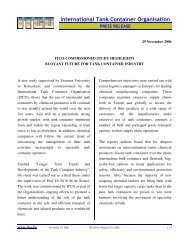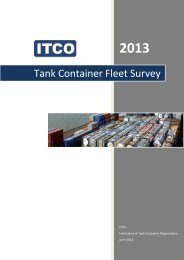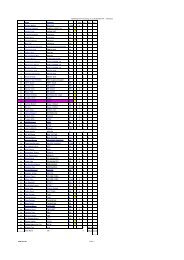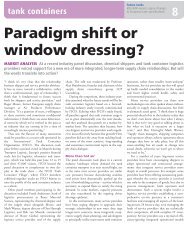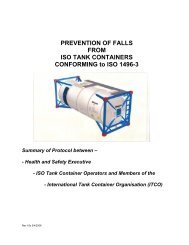Create successful ePaper yourself
Turn your PDF publications into a flip-book with our unique Google optimized e-Paper software.
ICHCA International <strong>Safe</strong>ty Panel Briefing Pamphlet No 30<br />
3.1.4.5 Both examples show low volume pressure vessels 17,500 lt.<br />
3.1.4.6 Picture 5 shows four 10ft<br />
ISO International beam<br />
tanks, being carried as<br />
two 20ft units. In this<br />
example two 10ft units<br />
are connected using<br />
approved horizontal<br />
interbox connectors and<br />
the design tested in that<br />
configuration. They can<br />
then be loaded, handled<br />
and stowed in the same<br />
way as any 20ft ISO tank<br />
container.<br />
3.1.5 Collar <strong>Tank</strong>s<br />
3.1.5.1 The collar tank is probably the simplest <strong>of</strong> all the tank designs with a<br />
minimum <strong>of</strong> differing materials in contact with the pressure vessel.<br />
Attachment <strong>of</strong> the pressure vessel to the end frames is by means <strong>of</strong> a<br />
stainless steel collar which is welded to the pressure vessel end dome at the<br />
edge (out-set) or to the crown <strong>of</strong> the domed ends <strong>of</strong> the pressure vessel (inset).<br />
The collar connects with the side posts, top and bottom rails and the<br />
diagonal braces via interface flanges.<br />
3.1.5.2 The collar is continuous at the front /<br />
non discharge end. At the rear <strong>of</strong> the<br />
tank container some collar tank<br />
designs have a break in the collar<br />
where the discharge valve is<br />
located.<br />
3.1.5.3 Picture 6 shows an insulated 25,000<br />
litre collar tank. Once insulated it is<br />
virtually impossible to distinguish<br />
between the inset and outset collar<br />
design.<br />
3.2 <strong>Tank</strong> Swap Bodies (Swap <strong>Tank</strong>s)<br />
3.2.1 The options for the design <strong>of</strong> the swap tanks are far less sophisticated than<br />
for ISO tanks. However the most important difference relates to their<br />
handling and stacking capabilities. All swap tanks have bottom fittings at the<br />
ISO 20ft or 40ft locations. Generally the bottom fittings are wider than their<br />
ISO counterparts, this is so that the bottom aperture is in the correct ISO<br />
position / width while the outer face <strong>of</strong> the bottom fitting extends to the full<br />
width if the unit (2.5 / 2.55m).<br />
3.2.2 Stackable<br />
Picture 5<br />
Picture 6<br />
3.2.2.1 The majority <strong>of</strong> recently built swap tanks are now stackable and 85 % <strong>of</strong> all<br />
swap tanks have top and side lifting capability.<br />
3.2.2.2 When considering stacking swap tanks it is important to differentiate<br />
between swap tanks and ISO containers which can be done by looking at<br />
the configuration <strong>of</strong> the top fitting and the side post. One <strong>of</strong> the<br />
characteristics that will be seen on the majority <strong>of</strong> all <strong>of</strong> these units is the<br />
double side lifting aperture, one in the post and the other in the fitting as<br />
Page 4 ©ICHCA International Limited



